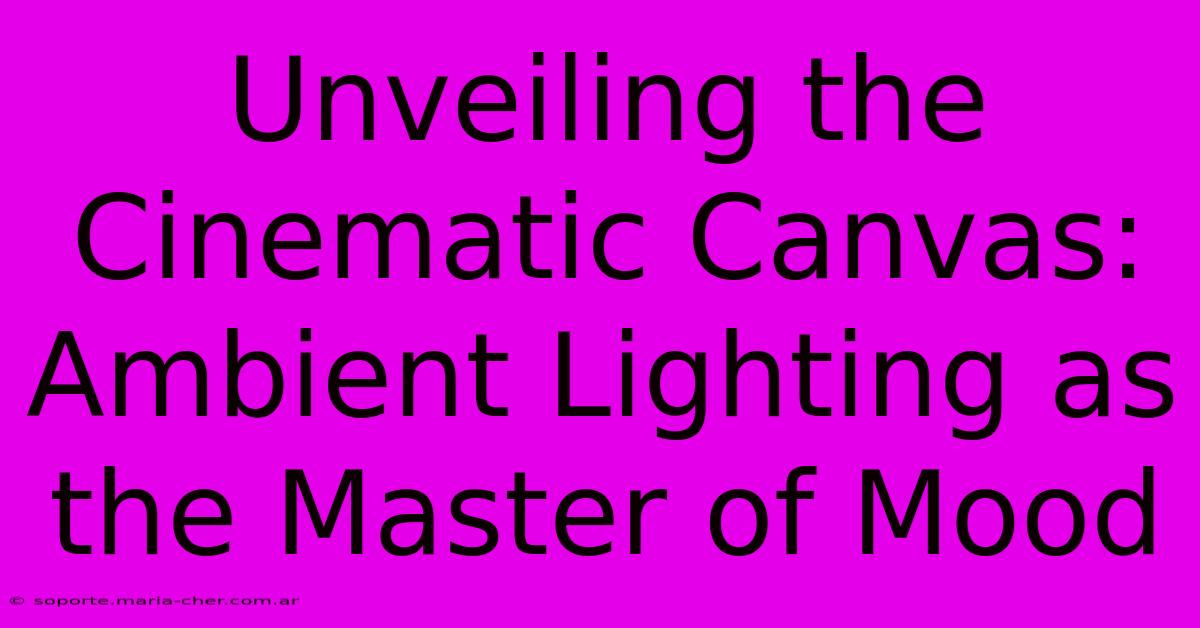Unveiling The Cinematic Canvas: Ambient Lighting As The Master Of Mood

Table of Contents
Unveiling the Cinematic Canvas: Ambient Lighting as the Master of Mood
Ambient lighting. It's not just about illuminating a scene; it's about crafting an experience. In filmmaking, and even in photography, ambient light is the unsung hero, the subtle maestro orchestrating mood, emotion, and narrative. Understanding and mastering its use is key to elevating your visual storytelling to a new level. This article delves into the powerful role of ambient lighting, exploring its techniques and the impact it has on the cinematic canvas.
Defining Ambient Lighting: More Than Just Illumination
Unlike harsh, direct lighting, ambient light is the overall light present in a scene before any artificial sources are introduced. Think of it as the existing light: the soft glow of dawn, the deep shadows of twilight, the diffused light filtering through a forest canopy. It's the foundation upon which other lighting styles are built. This subtle, pervasive light shapes the overall atmosphere and significantly impacts the viewer's emotional response.
The Emotional Spectrum of Ambient Light
The character of ambient light dictates the emotional tone. Consider these examples:
-
Warm, golden hues: These evoke feelings of comfort, nostalgia, and even romance. Think of a sun-drenched beach scene or a cozy fireplace setting.
-
Cool, blue tones: These often suggest feelings of isolation, mystery, or even coldness. A moonlit night or a dimly lit alleyway instantly conveys a different atmosphere.
-
Harsh, high-contrast light: This can create tension, drama, and even a sense of unease. Think of stark shadows in a thriller or the bright, unforgiving sun on a desolate landscape.
Mastering Ambient Light in Your Projects
Harnessing the power of ambient lighting requires careful observation and planning. Here are some key considerations:
1. Location Scouting: The Foundation of Ambient Light
The location itself is your first and most significant light source. Spend time scouting locations, considering the time of day, weather conditions, and the inherent light quality of the space. A dark, gothic cathedral will naturally lend itself to a different mood than a bright, airy beach house.
2. Time of Day: Harnessing the Golden Hour and Beyond
The "golden hour," the period shortly after sunrise and before sunset, offers beautifully diffused, warm light, perfect for creating a magical atmosphere. However, the "blue hour," the twilight period, offers a completely different, moodier palette. Experimenting with different times of day will dramatically alter the feel of your scenes.
3. Weather Conditions: Nature's Lighting Effects
Rain, fog, and even clouds all act as natural diffusers, softening harsh light and creating a more atmospheric feel. Embrace these natural filters to add depth and complexity to your ambient light.
4. Utilizing Natural Reflectors: Bouncing Light for Softness
Surfaces like water, snow, and even light-colored walls can reflect ambient light, creating subtle fills and softening harsh shadows. Understanding how these reflectors interact with your existing light source can enhance the overall mood.
Ambient Light and Other Lighting Techniques: A Synergistic Approach
Ambient light isn't used in isolation. It often works in harmony with other lighting techniques, such as:
-
Fill light: Used to soften shadows created by key light or back light.
-
Key light: The main light source illuminating your subject.
-
Back light: Used to separate the subject from the background and add depth.
By carefully balancing ambient light with these other techniques, you can create a richer, more nuanced visual story.
Conclusion: The Art of Subtlety
Ambient lighting is a powerful tool for filmmakers and photographers alike. By understanding its characteristics and mastering its application, you can elevate your work beyond mere illumination and create truly cinematic and emotionally resonant images. The key lies in observing, experimenting, and learning to appreciate the subtle power of the existing light. It's about more than just seeing the light; it's about feeling it.

Thank you for visiting our website wich cover about Unveiling The Cinematic Canvas: Ambient Lighting As The Master Of Mood. We hope the information provided has been useful to you. Feel free to contact us if you have any questions or need further assistance. See you next time and dont miss to bookmark.
Featured Posts
-
Revolutionize Your Color Management X Rite Color Checker Lightroom Unveiled
Feb 03, 2025
-
Censoris Grammys Outfit Stuns
Feb 03, 2025
-
Pro Bowl 2025 Nfc Beats Afc Again
Feb 03, 2025
-
La Vine Fox In Potential 3 Team Trade
Feb 03, 2025
-
Sabrina Carpenters 2025 Grammys Gown
Feb 03, 2025
